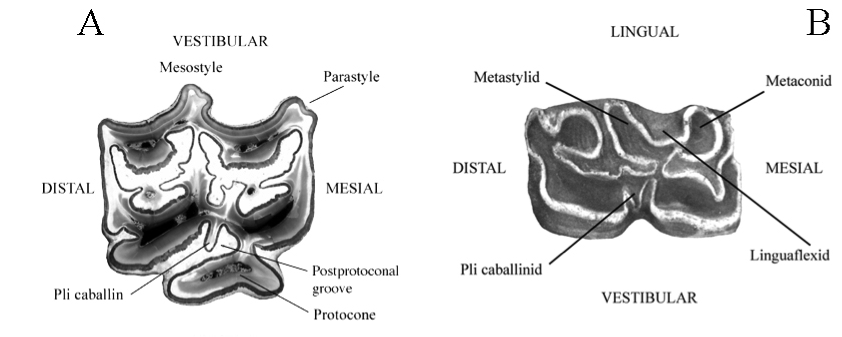Caballines Characters
SKULLS
The Franck’s Index, is commonly supposed to characterize true (i.e. caballine) Equus, and discriminate them from other extant Equus (Forsten and Eisenmann 1995). The Franck’s Index compares the distance from Staphylion (posterior border of palate) to Hormion (posterior border of vomer), and the distance from Hormion to Basion (anterior border of foramen magnum). In true horses, contrary to Asses and Donkeys, the latter is longer than the former so that on a scatter diagram the boundary line between Caballine and other skulls is "y=x". This line leaves just a few Caballines wrongly placed among ’Other Equus’. Unfortunately, a great number of ’Other Equus’ are wrongly placed among Caballines (Eisenmann 2006) 148.Discriminating Equus skulls : The Franck’s Index and the new Palatal Index. .
Another index, the Palatal Index may help in this discrimination. The Palatal Index compares the palatal length (between a line uniting the anterior borders of P2 and the Staphylion) to the distance from Staphylion to Hormion. In Caballines, the Palatal length is always longer than the distance between Staphylion and Hormion but again, many ’other’ skulls are placed on the caballine side of y=x. If, however, this boundary line is shifted up the y axis ("y=x+20"), the overlap is reduced. This rough discrimination will no doubt be refined by statistical elaboration, but for all practical purposes, the Palatal Index may already prove useful as it is.
Moreover, the Palatal Index may be used when the posterior - cranial - part of the skull is missing or damaged while the Franck’s Index may be used in the opposite case - when the damage concerns the anterior - facial - part of the skull. Thus, the indices are somewhat complementary and may be alternatively used in fragmentary skulls, keeping in mind the restrictions noted above.
CHEEK TEETH
The discrimination is difficult. It is based on several typical morphological and biometrical characters, which are far from constant and not always associated.
Fig. Upper (A) and lower (B) right premolars of E. caballus.
In typical upper cheek teeth:
1. The parastyle and mesostyle are grooved at least on premolars.
2. The vestibular enamel in front and back of the mesostyle is concave.
3. The pli caballin is present at least on premolars.
4. The postprotoconal groove is not very deep.
5. The protocone is long and assymetric, being less developed mesially than distally.
In typical lower cheek teeth:
1. The linguaflexid is angular.
2. The double knot (metaconid + linguaflexid + metastylid) is assymetric.
3. The metastylid is pointed.
4. The pli caballinid is present at least on premolars.
The lower molars are often more typical than the premolars. Contrary to some assertions, the vestibular groove of the molars may be either shallow or deep.
Véra Eisenmann
Articles by this author
- Eisenmann V, Howe J., Pichardo M. Old World hemiones ans New World slender species (Mammalia, Equidae)species
- Predictive use of modern reference osteological colections for disentangling the shape of Eurasiatic equid cheek teeth and metapodials in archaeological material
- The equids from Liventsovka and other localities of the Khaprovskii Faunal Complex, Russia: A revision
- The Late Middle Pleistocene Oumm Qatafa mammalian fauna of Oumm Qatafa, Judean Desert
- Additional Information
- [...]
![]() en
en
![]() Equidae monodactyles
Equidae monodactyles
![]() Caballins
?
Caballins
?
Site powered by SPIP 4.3.3 + AHUNTSIC
Réalisé par agence web Epistrophe |